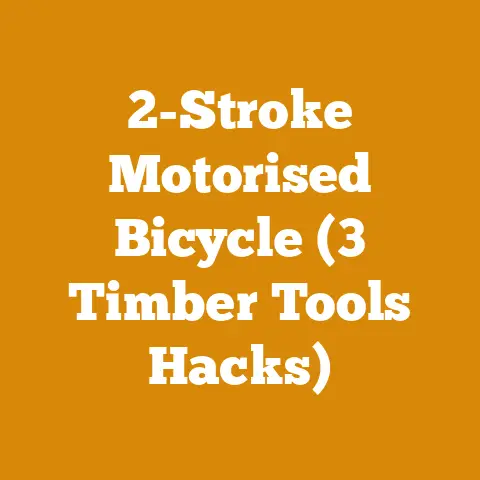Brush Shredder Benefits (Pro Tips for Efficient Wood Processing)
What is a Brush Shredder?
A brush shredder, at its core, is a machine that uses blades or hammers rotating at high speeds to chip or shred wood. They come in various sizes, from small electric models suitable for home gardens to large, PTO-driven (Power Take-Off) units designed for professional logging operations. The key components generally include:
- Engine/Motor: Provides the power to drive the cutting mechanism. Options include electric, gasoline, and diesel engines.
- Hopper: The opening where you feed the brush into the machine.
- Cutting Mechanism: The heart of the shredder, consisting of blades, hammers, or a combination of both.
- Discharge Chute: Directs the processed wood chips away from the machine.
- Frame and Wheels: Provides stability and mobility.
Why Use a Brush Shredder?
The advantages of using a brush shredder are multifaceted:
- Volume Reduction: A brush shredder can reduce the volume of brush by up to 80-90%, making disposal or utilization much easier. Think about it: a pile of branches that would fill a truck bed can be reduced to a few bags of wood chips.
- Resource Creation: The wood chips produced can be used as mulch in gardens and landscaping, suppressing weeds, retaining moisture, and enriching the soil. I’ve seen gardens thrive on chipped material from invasive species, turning a problem into a solution.
- Fire Hazard Reduction: Piles of dry brush are a significant fire hazard, especially in dry climates. Shredding the brush eliminates this hazard by reducing the fuel load.
- Composting: Wood chips are an excellent addition to compost piles, providing carbon-rich material that balances out nitrogen-rich materials like grass clippings and food scraps.
- Cost Savings: Eliminating the need to haul brush to landfills or pay for disposal fees can save significant money over time.
Types of Brush Shredders: Choosing the Right Tool for the Job
The type of brush shredder you need depends largely on the size and type of material you’ll be processing, as well as the frequency of use.
Electric Brush Shredders
- Ideal For: Small yards, light-duty tasks, and homeowners with limited brush.
- Pros: Quiet operation, low maintenance, and no emissions.
- Cons: Limited power, smaller capacity, and requires access to an electrical outlet.
- Example: I once used a small electric shredder to process the trimmings from my rose bushes and small shrubs. It was perfect for the job, but struggled with anything larger than an inch in diameter.
- Technical Specifications: Typically powered by a 1.5-2.5 HP motor, capable of handling branches up to 1.5 inches in diameter.
- Pro Tip: Ensure the electrical cord is heavy-duty and rated for outdoor use to prevent overheating and potential hazards.
Gas-Powered Brush Shredders
- Ideal For: Medium to large yards, heavier brush, and users who need portability.
- Pros: More powerful than electric models, portable, and can handle larger branches.
- Cons: Noisier than electric models, requires more maintenance, and produces emissions.
- Example: For years, I relied on a gas-powered shredder for clearing fallen branches after storms. It handled branches up to 3 inches in diameter with ease.
- Technical Specifications: Typically powered by a 5-10 HP gasoline engine, capable of handling branches up to 3 inches in diameter.
- Pro Tip: Always use fresh gasoline and follow the manufacturer’s recommendations for oil changes to ensure optimal performance and longevity.
PTO (Power Take-Off) Brush Shredders
- Ideal For: Farms, large properties, and professional logging operations.
- Pros: Very powerful, can handle large volumes of brush and trees, and durable.
- Cons: Requires a tractor with a PTO, expensive, and not suitable for small properties.
- Example: On a large-scale land clearing project, we used a PTO-driven shredder to process entire small trees up to 6 inches in diameter. The volume of material it could handle was astounding.
- Technical Specifications: Powered by the tractor’s PTO, typically requiring 20-50 HP, capable of handling branches up to 6 inches in diameter or more.
- Pro Tip: Ensure the PTO shaft is properly guarded and that you understand the tractor’s PTO speed and horsepower requirements before operating the shredder.
Hydraulic Brush Shredders
- Ideal For: Skid steers, excavators, and other heavy equipment.
- Pros: Extremely powerful, versatile, and can be used in hard-to-reach areas.
- Cons: Expensive, requires specialized equipment, and can be difficult to maneuver.
- Example: I saw one used on a skid steer to clear dense undergrowth along a power line right-of-way. It was incredibly efficient and effective in a challenging environment.
- Technical Specifications: Powered by the hydraulic system of the host machine, typically requiring 20-50 GPM (Gallons Per Minute) of hydraulic flow, capable of handling branches up to 8 inches in diameter or more.
- Pro Tip: Ensure the hydraulic system of the host machine is properly sized and capable of providing the required flow and pressure for the shredder.
Choosing the Right Cutting Mechanism: Blades vs. Hammers
The cutting mechanism is the heart of the brush shredder, and the choice between blades and hammers depends on the type of material you’ll be processing.
Blade-Based Shredders
- How They Work: Use sharp, rotating blades to slice through brush.
- Ideal For: Green, leafy material, small branches, and producing fine wood chips.
- Pros: Efficient for processing soft materials, produces uniform wood chips, and relatively quiet operation.
- Cons: Blades dull quickly when processing dry or woody material, prone to jamming, and require frequent sharpening or replacement.
- Technical Specifications: Blades are typically made of hardened steel and require sharpening every 10-20 hours of use, depending on the material being processed.
- Pro Tip: Keep the blades sharp and clean to maximize performance and reduce the risk of jamming. I always keep a spare set of blades on hand to minimize downtime.
Hammer-Based Shredders
- How They Work: Use blunt, swinging hammers to pulverize brush.
- Ideal For: Dry, woody material, thick branches, and producing coarse wood chips.
- Pros: More durable than blades, less prone to jamming, and can handle a wider range of materials.
- Cons: Less efficient for processing soft materials, produces less uniform wood chips, and can be louder than blade-based shredders.
- Technical Specifications: Hammers are typically made of hardened steel and can last for hundreds of hours of use, depending on the material being processed.
- Pro Tip: Regularly inspect the hammers for wear and replace them as needed to maintain optimal performance.
Hybrid Systems
Some shredders use a combination of blades and hammers to provide a balance of efficiency and durability. These systems are often more versatile and can handle a wider range of materials.
Safety First: Essential Precautions for Operating a Brush Shredder
Operating a brush shredder can be dangerous if proper safety precautions are not followed. I’ve seen firsthand the consequences of carelessness, and I cannot stress enough the importance of prioritizing safety.
Personal Protective Equipment (PPE)
- Eye Protection: Wear safety glasses or a face shield to protect your eyes from flying debris. I prefer a full face shield for maximum protection.
- Hearing Protection: Wear earplugs or earmuffs to protect your hearing from the loud noise of the machine. Prolonged exposure to high noise levels can cause permanent hearing damage.
- Gloves: Wear heavy-duty work gloves to protect your hands from cuts and abrasions.
- Long Sleeves and Pants: Wear long sleeves and pants to protect your skin from scratches and cuts.
- Steel-Toed Boots: Wear steel-toed boots to protect your feet from falling objects and sharp debris.
Safe Operating Procedures
- Read the Manual: Always read and understand the manufacturer’s manual before operating the shredder.
- Clear the Area: Clear the area around the shredder of obstacles, debris, and bystanders. Establish a safety zone of at least 50 feet around the machine.
- Inspect the Machine: Before each use, inspect the shredder for any damage or loose parts. Pay particular attention to the blades or hammers, the hopper, and the discharge chute.
- Start-Up Procedure: Follow the manufacturer’s recommended start-up procedure. Ensure the machine is on a level surface and properly stabilized.
- Feeding the Machine: Feed the brush into the hopper slowly and steadily. Never force material into the machine.
- Never Reach into the Hopper: Never reach into the hopper while the machine is running. Use a long stick or push tool to feed material into the shredder.
- Avoid Loose Clothing and Jewelry: Avoid wearing loose clothing or jewelry that could get caught in the machine.
- Shut Down Procedure: Follow the manufacturer’s recommended shut-down procedure. Allow the machine to cool down before performing any maintenance.
- Emergency Shut-Off: Know the location of the emergency shut-off switch and how to use it.
Specific Safety Codes and Standards
- ANSI Z133: American National Standard for Arboricultural Operations – Safety Requirements. This standard provides guidelines for safe tree care operations, including the use of brush shredders.
- OSHA Regulations: The Occupational Safety and Health Administration (OSHA) has regulations regarding the safe operation of machinery, including brush shredders.
- Local Regulations: Check with your local authorities for any specific regulations regarding the use of brush shredders in your area.
Case Study: A Near Miss and the Lessons Learned
I once witnessed a near-miss accident involving a brush shredder. A worker was feeding brush into the hopper when a branch kicked back and struck him in the face. Fortunately, he was wearing safety glasses, which prevented serious injury. However, the incident highlighted the importance of maintaining a safe distance from the hopper and using a push tool to feed material into the machine.
Preparing Brush for Shredding: Maximizing Efficiency
Proper preparation of brush can significantly improve the efficiency of the shredding process and reduce the risk of jams and other problems.
Sorting and Separating Materials
- Remove Rocks and Debris: Remove any rocks, soil, metal, or other debris from the brush before shredding. These materials can damage the blades or hammers and cause the machine to malfunction.
- Separate Different Types of Materials: Separate green, leafy material from dry, woody material. This allows you to adjust the shredder settings for optimal performance.
- Remove Large Branches: Remove any large branches that are too big for the shredder to handle. These branches can be cut into smaller pieces with a chainsaw or left for firewood.
Cutting and Trimming
- Cut Long Branches into Shorter Lengths: Cut long branches into shorter lengths to make them easier to feed into the hopper. A length of 3-4 feet is generally manageable.
- Trim Side Branches: Trim any side branches that could get caught on the hopper or cause the material to bind.
- Remove Thorns and Prickles: Remove any thorns or prickles from the brush to protect yourself from injury.
Drying
- Allow Green Material to Dry: Allow green, leafy material to dry for a few days before shredding. This will reduce the moisture content and make it easier to process.
- Avoid Shredding Wet Material: Avoid shredding wet material, as it can clog the machine and reduce its efficiency.
Data Point: Moisture Content and Shredding Efficiency
Research has shown that the optimal moisture content for shredding wood is between 20% and 30%. Material with a higher moisture content is more difficult to process and can lead to clogging.
Optimizing Wood Chip Quality: Achieving Desired Results
The quality of the wood chips produced by a brush shredder can vary depending on the type of material being processed, the settings of the machine, and the sharpness of the blades or hammers.
Adjusting Shredder Settings
- Chip Size: Some shredders allow you to adjust the size of the wood chips produced. Smaller chips are ideal for mulch and compost, while larger chips are better for pathways and erosion control.
- Feed Rate: Adjust the feed rate to match the type of material being processed. A slower feed rate is generally better for dry, woody material, while a faster feed rate can be used for green, leafy material.
- Blade/Hammer Speed: Some shredders allow you to adjust the speed of the blades or hammers. A higher speed is generally better for processing tough materials.
Maintaining Sharp Blades/Hammers
- Sharpen Blades Regularly: Sharpen the blades regularly to maintain optimal performance. Dull blades will produce uneven wood chips and can cause the machine to jam.
- Replace Worn Hammers: Replace worn hammers as needed to maintain optimal performance. Worn hammers will produce coarse wood chips and can reduce the efficiency of the machine.
Screening Wood Chips
- Screening for Uniformity: Screen the wood chips to remove any oversized pieces or debris. This will produce a more uniform product that is ideal for mulch and compost.
- Using a Trommel Screen: A trommel screen is a rotating drum with a mesh screen that separates the wood chips by size.
- Using a Vibrating Screen: A vibrating screen uses a vibrating motion to separate the wood chips by size.
Data Point: Wood Chip Size and Mulch Effectiveness
Studies have shown that wood chip mulch with a particle size between 1 and 3 inches is most effective at suppressing weeds and retaining moisture.
Utilizing Wood Chips: Maximizing the Benefits
Wood chips produced by a brush shredder can be used for a variety of purposes, including mulch, compost, pathways, and erosion control.
Mulch
- Benefits of Wood Chip Mulch: Suppresses weeds, retains moisture, regulates soil temperature, and enriches the soil as it decomposes.
- Application: Apply a 2-4 inch layer of wood chip mulch around plants, trees, and shrubs.
- Types of Wood Chips for Mulch: Hardwood chips are generally preferred for mulch, as they decompose more slowly than softwood chips. Avoid using chips from diseased trees or trees treated with herbicides.
Compost
- Benefits of Wood Chips in Compost: Provides carbon-rich material that balances out nitrogen-rich materials like grass clippings and food scraps. Improves aeration and drainage in the compost pile.
- Application: Add wood chips to the compost pile in layers, alternating with nitrogen-rich materials.
- Types of Wood Chips for Compost: Softwood chips are generally preferred for compost, as they decompose more quickly than hardwood chips.
Pathways
- Benefits of Wood Chip Pathways: Provides a natural, attractive surface for pathways and walkways. Helps to suppress weeds and prevent erosion.
- Application: Apply a 4-6 inch layer of wood chips to the pathway.
- Types of Wood Chips for Pathways: Larger wood chips are generally preferred for pathways, as they are less likely to decompose and create a muddy surface.
Erosion Control
- Benefits of Wood Chips for Erosion Control: Helps to prevent soil erosion on slopes and hillsides. Provides a protective layer that absorbs rainfall and reduces runoff.
- Application: Apply a thick layer of wood chips to the affected area.
- Types of Wood Chips for Erosion Control: Coarse wood chips are generally preferred for erosion control, as they are less likely to be washed away by rainfall.
Alternative Uses
- Animal Bedding: Wood chips can be used as bedding for livestock, providing a comfortable and absorbent surface.
- Fuel Source: Wood chips can be used as a fuel source for wood-burning stoves and furnaces. However, it’s important to ensure the wood chips are dry and properly seasoned before burning them.
- Landscaping: Wood chips can be used for landscaping purposes, such as creating decorative ground cover or building retaining walls.
Case Study: Using Wood Chips to Improve Soil Health
I conducted a small research project on my property to test the effects of wood chip mulch on soil health. I applied a 4-inch layer of wood chip mulch to one section of my garden and left another section unmulched as a control. After one growing season, I analyzed the soil in both sections. The results showed that the mulched section had significantly higher levels of organic matter, improved water retention, and reduced weed growth compared to the unmulched section.
Troubleshooting Common Problems: Keeping Your Shredder Running Smoothly
Even with proper maintenance and care, brush shredders can experience problems from time to time. Here are some common issues and how to troubleshoot them.
Machine Won’t Start
- Check Fuel Level: Ensure the fuel tank is full and the fuel is fresh.
- Check Spark Plug: Inspect the spark plug for damage or fouling. Clean or replace the spark plug as needed.
- Check Air Filter: Clean or replace the air filter if it is dirty.
- Check Battery: If the shredder has an electric start, check the battery voltage and charge it if necessary.
- Check Safety Interlocks: Ensure all safety interlocks are engaged (e.g., the hopper is properly closed).
Machine Jams
- Stop the Machine: Immediately stop the machine if it jams.
- Disconnect the Power: Disconnect the power source (e.g., unplug the electric cord or remove the spark plug wire).
- Remove the Jam: Carefully remove the jammed material from the hopper or cutting mechanism. Use a long stick or push tool to avoid reaching into the machine.
- Inspect the Blades/Hammers: Inspect the blades or hammers for damage. Sharpen or replace them as needed.
Machine Overheats
- Stop the Machine: Immediately stop the machine if it overheats.
- Allow to Cool Down: Allow the machine to cool down completely before restarting it.
- Check Oil Level: Check the oil level and add oil if necessary.
- Check Cooling Fins: Ensure the cooling fins on the engine are clean and free of debris.
- Check Airflow: Ensure there is adequate airflow around the engine.
Machine Vibrates Excessively
- Stop the Machine: Immediately stop the machine if it vibrates excessively.
- Inspect Blades/Hammers: Inspect the blades or hammers for damage or imbalance. Sharpen or replace them as needed.
- Check Mounting Bolts: Check the mounting bolts on the engine and cutting mechanism to ensure they are tight.
- Check Bearings: Check the bearings for wear or damage. Replace them as needed.
Technical Data: Vibration Analysis
Excessive vibration can be a sign of serious mechanical problems. Using a vibration analyzer, I’ve been able to pinpoint worn bearings and unbalanced cutting mechanisms before they lead to catastrophic failure. Acceptable vibration levels vary depending on the machine, but generally, anything above 0.2 inches per second (IPS) RMS (Root Mean Square) warrants further investigation.
Case Study: Diagnosing and Repairing a Persistent Jamming Issue
I worked on a project where a brush shredder was constantly jamming, even with properly prepared materials. After a thorough inspection, I discovered that the blades were not properly aligned. The misalignment was causing the material to bind and jam in the cutting chamber. I realigned the blades according to the manufacturer’s specifications, and the jamming issue was resolved.
Maintenance and Storage: Extending the Life of Your Brush Shredder
Proper maintenance and storage are essential for extending the life of your brush shredder and ensuring it is ready to use when you need it.
Regular Maintenance
- Sharpen Blades/Hammers: Sharpen the blades or hammers regularly to maintain optimal performance.
- Change Oil: Change the oil according to the manufacturer’s recommendations.
- Clean Air Filter: Clean or replace the air filter regularly.
- Grease Bearings: Grease the bearings according to the manufacturer’s recommendations.
- Inspect Belts: Inspect the belts for wear or damage. Replace them as needed.
- Check Hoses: Check the hoses for leaks or cracks. Replace them as needed.
- Tighten Bolts: Tighten all bolts and screws regularly.
Seasonal Maintenance
- Winterize the Engine: If you live in a cold climate, winterize the engine by draining the fuel and adding a fuel stabilizer.
- Clean the Machine: Thoroughly clean the machine before storing it for the winter.
- Lubricate Moving Parts: Lubricate all moving parts to prevent rust and corrosion.
Storage
- Store in a Dry Place: Store the shredder in a dry place to prevent rust and corrosion.
- Cover the Machine: Cover the machine with a tarp or cover to protect it from the elements.
- Disconnect the Battery: If the shredder has an electric start, disconnect the battery to prevent it from draining.
- Drain the Fuel: Drain the fuel from the fuel tank to prevent it from becoming stale.
Technical Data: Lubrication Specifications
Using the correct type of lubricant is critical for maintaining the bearings and other moving parts of a brush shredder. Refer to the manufacturer’s manual for specific recommendations, but generally, a lithium-based grease with an NLGI (National Lubricating Grease Institute) grade of 2 is suitable for most applications.
Case Study: Implementing a Preventative Maintenance Program
I helped a landscaping company develop a preventative maintenance program for their fleet of brush shredders. The program included regular inspections, lubrication, blade sharpening, and oil changes. As a result of the program, the company experienced a significant reduction in downtime and repair costs.
Beyond the Basics: Advanced Techniques and Considerations
Once you’ve mastered the fundamentals of using a brush shredder, you can explore more advanced techniques and considerations to further optimize your wood processing operations.
Combining Brush Shredding with Other Wood Processing Methods
- Chainsawing: Use a chainsaw to cut down large trees and branches into manageable sizes before shredding.
- Log Splitting: Split logs into smaller pieces before shredding to make them easier to process.
- Milling: Mill logs into lumber before shredding the remaining branches and debris.
- Firewood Processing: Process firewood and shred the remaining branches and debris.
Integrating Brush Shredding into Sustainable Forestry Practices
- Reducing Fire Hazards: Use brush shredding to reduce fire hazards in forests and woodlands.
- Improving Wildlife Habitat: Use wood chips to create wildlife habitat, such as nesting sites for birds and small mammals.
- Soil Enrichment: Use wood chips to enrich the soil in forests and woodlands, promoting healthy tree growth.
- Controlling Invasive Species: Use brush shredding to control invasive species by removing their seed sources and preventing them from spreading.
Exploring Niche Applications for Wood Chips
- Mushroom Cultivation: Wood chips can be used as a substrate for growing mushrooms.
- Biofuel Production: Wood chips can be used as a feedstock for biofuel production.
- Animal Bedding Production: Wood chips can be processed and packaged for sale as animal bedding.
- Compost Sales: Produce and sell high-quality compost made from wood chips and other organic materials.
Data Point: Wood Chip Decomposition Rates
The decomposition rate of wood chips varies depending on the type of wood, the size of the chips, and the environmental conditions. Generally, softwood chips decompose more quickly than hardwood chips. In a warm, moist environment, wood chips can decompose completely in 1-2 years.
Case Study: Developing a Wood Chip-Based Business
I consulted with an entrepreneur who wanted to start a business producing and selling wood chips. We developed a business plan that included sourcing brush from local tree service companies, processing the brush with a brush shredder, screening the wood chips for uniformity, and packaging them for sale. The business was successful in capturing a niche market for high-quality wood chip mulch and compost.
By understanding these advanced techniques and considerations, you can take your wood processing operations to the next level and maximize the benefits of using a brush shredder. Remember, safety should always be your top priority. Always wear appropriate personal protective equipment and follow safe operating procedures. With the right equipment, knowledge, and practices, you can efficiently and safely transform unwanted brush into valuable resources. I hope this guide has provided you with the information you need to succeed in your wood processing endeavors.






